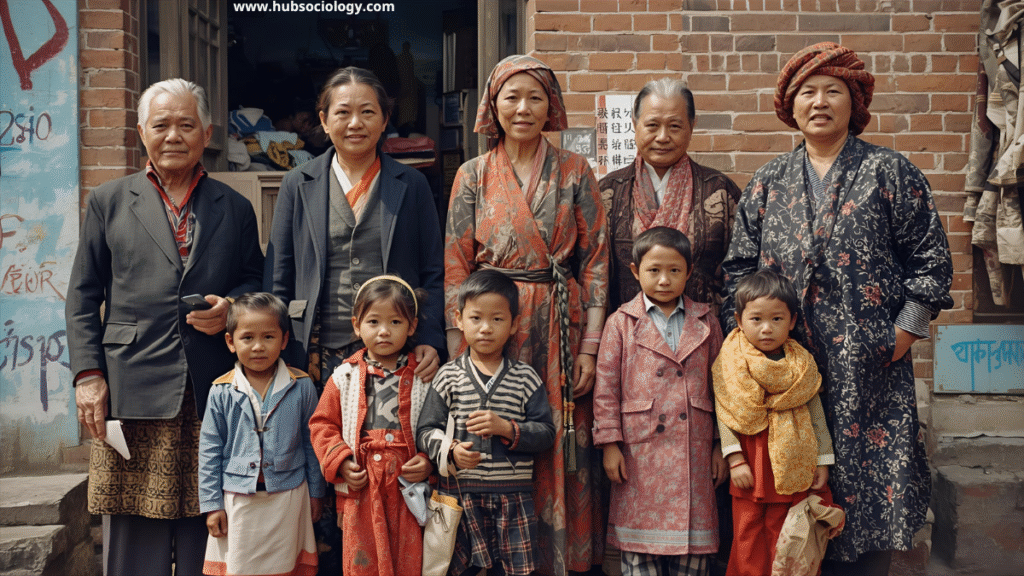Introduction on Sociology and Social Demography
Sociology, as the scientific study of human society, social relationships, and institutions, seeks to understand how individuals and groups interact within a structured social environment. Social demography, on the other hand, is a specialized branch of sociology that deals with the study of population size, structure, distribution, and the processes of change such as fertility, mortality, and migration. While sociology focuses broadly on society, culture, and social institutions, social demography narrows its scope to the study of human populations in their social contexts.
The relationship between the two is therefore both intrinsic and complementary: sociology provides the theoretical framework for understanding human behavior, while social demography provides empirical population data that explain how demographic processes shape and are shaped by society.
This article aims to explore the nature of the relationship between sociology and social demography, their interdependence, and their role in analyzing societal changes in a sociological perspective.

Table of Contents
Meaning of Sociology
Sociology is the discipline that studies society in its entirety. It examines the structures, institutions, interactions, norms, and values that bind individuals into a collective social life. Auguste Comte, the “father of sociology,” envisioned sociology as the “queen of sciences” that could uncover the laws governing human society. Over time, sociology has expanded into diverse subfields such as social stratification, family, education, politics, economy, and demography. Its primary concern is to understand how social order is maintained and how changes take place within it.
Meaning of Social Demography
Social demography is a branch of sociology that focuses on population studies. It is not merely a statistical description of population figures but an analysis of how social and demographic variables interact. It investigates patterns of fertility, mortality, marriage, migration, age structure, urbanization, and population growth. Social demography connects these population processes with social institutions, cultural norms, economic changes, and political developments. For example, studying declining fertility cannot be complete without analyzing changes in women’s education, family structures, and gender roles—areas traditionally studied within sociology.
Historical Development of the Relationship
The relation between sociology and demography has historical roots. Early sociologists such as Herbert Spencer, Émile Durkheim, and Karl Marx gave importance to population dynamics in understanding society. Durkheim, in his study of suicide, used demographic statistics to reveal the social causes behind what seemed to be individual acts. Marx also considered population growth in relation to capitalist modes of production, arguing that demographic patterns were linked to class relations and economic structures.
By the 20th century, demography emerged as a distinct field of inquiry, but its sociological orientation remained strong. The concept of “social demography” arose to highlight the inseparability of population studies from their social contexts. Thus, sociology and demography evolved together, influencing and enriching each other.
Areas of Interconnection between Sociology and Social Demography

- Population and Social Structure
Population composition affects the structure of society. A society with a large youth population experiences different challenges (such as education, employment, and political participation) compared to an aging society facing health care and pension issues. Sociology provides the theoretical analysis of these structural changes, while social demography supplies empirical data about population age, sex, and distribution. - Fertility and Family Systems
Fertility behavior is not just a biological process but also a social one. Education levels, religious beliefs, cultural norms, and economic status influence family planning decisions. Sociology explains these social variables, while social demography analyzes fertility rates and their impact on population growth. - Mortality and Health
Mortality is closely linked with health, sanitation, nutrition, and social inequality. Sociologists study how poverty, urbanization, and lifestyle affect health outcomes, while demographers measure mortality trends, life expectancy, and causes of death. Together, they explain not only how people die but also why mortality rates differ among social groups. - Migration and Social Change
Migration alters societies by changing cultural composition, labor markets, and social relations. Social demography studies migration flows, while sociology interprets the integration of migrants, the problems of multiculturalism, and the dynamics of social mobility. For example, large-scale rural-to-urban migration in India has transformed both rural family structures and urban slums. - Population Policies and Social Planning
Governments design population policies to manage fertility, health, and migration. Sociology helps policymakers understand cultural and social barriers to policy implementation, while social demography provides statistical evidence to guide planning. The synergy of both fields is crucial for effective development programs. - Social Stratification and Demographic Patterns
Social class, caste, gender, and ethnicity affect demographic behavior. For instance, marginalized communities often have higher fertility and mortality rates due to poverty and limited access to healthcare. Sociology studies the structure of inequality, and demography provides measurable data on its demographic consequences.
Theoretical Perspectives on the Relationship
- Functionalist Perspective
Functionalists view society as an organism where population changes affect equilibrium. For instance, declining fertility may lead to labor shortages, prompting changes in education or immigration policies. Social demography provides the demographic facts, while sociology interprets their social implications. - Conflict Perspective
Marxist and neo-Marxist theories argue that population issues cannot be understood without considering class conflicts and economic structures. Overpopulation is not a natural crisis but a reflection of inequality and exploitation. Demographic data, when analyzed sociologically, reveal how ruling classes benefit from population policies. - Interactionist Perspective
Symbolic interactionists focus on how individuals interpret demographic realities, such as family planning decisions or migration experiences. Social demography, in this case, provides micro-level data that sociology uses to explore personal meanings and social actions.
Importance of the Relationship in Contemporary Society
In the 21st century, the relationship between sociology and social demography has become even more crucial due to global challenges:
- Urbanization and Megacities: Sociologists study the social consequences of rapid urban growth, while demographers analyze urban population trends.
- Aging Population: Developed countries face the problem of aging societies, linking demographic data with sociological issues such as elder care and intergenerational relations.
- Migration and Globalization: Large-scale international migration raises questions of identity, citizenship, and multiculturalism, which sociology and demography together address.
- Gender and Fertility Decline: Women’s education and employment reshape fertility patterns, an area where sociology’s gender analysis complements demographic studies.
- Climate Change and Population: Rising populations in vulnerable areas increase ecological strain. Social demography provides data on population pressure, while sociology explores adaptation and resilience.

Criticisms and Challenges on Sociology and Social Demography
Despite their close connection, sociology and social demography face certain challenges. Some critics argue that demography is overly quantitative and risks ignoring the qualitative aspects of social life. On the other hand, purely sociological studies without demographic data may lack empirical grounding. Therefore, the challenge lies in integrating statistical analysis with sociological interpretation to achieve a holistic understanding of population and society.
Conclusion on Sociology and Social Demography
The relation between sociology and social demography is one of interdependence and mutual enrichment. Sociology provides the theoretical insights to interpret population behaviour, while social demography offers the empirical foundation to validate sociological theories. Together, they enable a comprehensive understanding of society’s dynamics, particularly in the context of population change. As contemporary societies grapple with issues such as migration, fertility decline, aging populations, and climate change, the collaboration of sociology and social demography becomes indispensable. Far from being separate disciplines, they are intertwined branches of social science that together illuminate the interaction between human populations and the social structures in which they live.
Do you like this this Article ? You Can follow as on :-
Facebook – https://www.facebook.com/hubsociology
Whatsapp Channel – https://whatsapp.com/channel/0029Vb6D8vGKWEKpJpu5QP0O
Gmail – hubsociology@gmail.com
Exam-Oriented Questions on Sociology and Social Demography
5 Marks Questions on Sociology and Social Demography
- Define social demography and explain its scope.
- Write any two differences between sociology and demography.
- Mention two ways in which fertility patterns influence society.
- How does migration bring social change?
- State the importance of population studies in sociology.
10 Marks Questions on Sociology and Social Demography
- Discuss the role of sociology in understanding fertility and mortality trends.
- Explain the interrelationship between migration and social mobility.
- How does social demography contribute to population policies?
- Analyze the significance of social stratification in demographic patterns.
- Discuss the functionalist and conflict perspectives on population changes.
15 Marks Questions on Sociology and Social Demography
- Critically examine the relationship between sociology and social demography with suitable examples.
- Discuss the role of social demography in understanding contemporary social issues such as aging population, urbanization, and globalization.
- Explain how social demography and sociology together contribute to development planning and policy-making in modern societies.
- Evaluate the challenges of integrating sociological theory with demographic data.
- “Sociology provides theory, and social demography provides empirical evidence.” – Discuss with reference to their interconnection.
